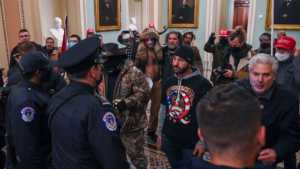Much of the world is still reflecting on the riots that transpired last week at the U.S. Capitol. Conversations about white supremacy, what it is, and how it manifests have intensified. In the summer of 2020, there was a renewed interest in books about white supremacy and anti-racism and a re-emergence of these types of books on the Amazon and New York Times best-seller lists. As the horrific events of racial injustice that marred 2020 lost the public’s interest, conversations about white supremacy started to wane. The insidious nature of white supremacy allows it to shapeshift often, which is part of the reason why it’s so difficult to eradicate. There are some common myths that demonstrate the public’s lack of understanding when it comes to white supremacy and how it permeates every facet of society. In an effort to close these gaps of misunderstanding, this article explores four commonly held misconceptions about white supremacy.
1. It is always intentional. The Anti-Defamation League conceptualizes white supremacy as the belief that the white race is superior to other races as well as the belief that more needs to be done to “save the white race.” A commonly held myth about white supremacy is that it is done intentionally. While this is often the case through innumerable laws and systems (e.g. redlining, American slavery, housing discrimination), we frequently uphold white supremacy in our lives without even realizing it. In the workplace, for example, company policies and practices may perpetuate white supremacy. Even our notion of professionalism is seen through a white-centered lens. A Black man for example, who decides to wear his hair in dreadlocks may be deemed unprofessional based on white standards. A corporate policy that upholds white beauty standards is just one of the plethora of ways we may unintentionally perpetuate white supremacy. As we should know by now, intention does not determine impact. Even if it is not our intention to uphold white supremacy, the impact is still the same and can be harmful and even deadly for Black Indigenous people of color (BIPOC).
2. It is only upheld by white people. Speaking of BIPOC, there is a commonly held belief that only white people uphold white supremacy. This is one of the most deceptive myths about white supremacy because it prevents BIPOC from exploring and examining the ways that they may individually sustain white supremacy. Just because you identify as a person of color doesn’t prevent you from propagating white supremacist views and ideologies. White supremacy in BIPOC communities often manifests as white adjacency: the act of aligning with whiteness and distancing yourself from your ethnic and racial identity in order to gain access and opportunities. White supremacy can also manifest as colorism, which is a persistent issue within India, Latin America, Africa and nearly every community of color. A mother who tells her daughter not to play out in the sun because her skin will get too dark is upholding white supremacy and subtly reinforcing the belief that proximity to whiteness via lighter skin makes a woman more beautiful. BIPOC can both uphold white supremacy and possess anti-black views. They are two sides of the same coin.
3. It is not common. There is this false narrative that white supremacists are these outspoken extremists; domestic terrorists that are seen protesting the removal of confederate monuments or committing horrific acts of violence and treason. These are extreme examples but white supremacy is more common than we think. By personifying white supremacists as these types of individuals, we overlook the white supremacists lurking in our workplaces, our schools, and within our communities. Nice people can also be white supremacists. Relinquish the idea that there is a prototype for white supremacy. Similarly, white supremacy knows no age. Being of a particular generation does not automatically prevent you from being a white supremacist. A frequently cited myth is that younger generations are “woke” and that white supremacy and racism are only displayed by older generations. Adopting this belief will prevent you from recognizing the white supremacy that infiltrates our everyday environment.
4. It disappears with a new leadership. White supremacy didn’t start with a particular president or leader. Removing a president or an administration doesn’t suddenly eliminate a country of its white supremacist structures and systems. Despite the fact that the United States elected its first Black president in 2008, research indicates that anti-black racism actually increased during President Obama’s tenure. Believing that white supremacy comes and goes with leadership prevents you from seeing how deep white supremacy runs in our laws, policies, systems and social mores that the collective adheres to. Changing the hearts and minds of people is fundamental and can be achieved through education, reading, and continued dialogue. It is important to note, however, that without systemic changes that address the specific inequities that have disadvantaged different groups of people within society for hundreds of years, a changed heart and mind doesn’t resolve the issue. Regardless of who is leading a country, there must be lifelong effort and action to eradicate white supremacy in every system and structure that exists.




